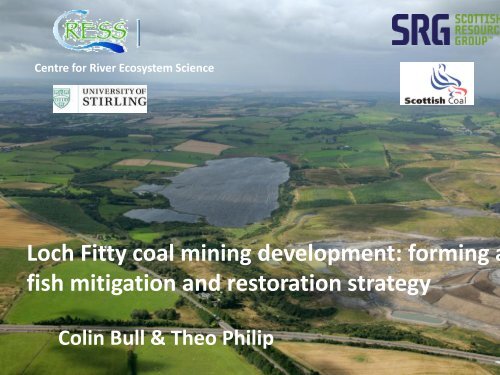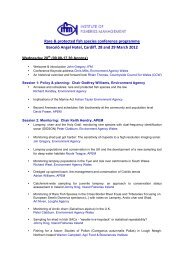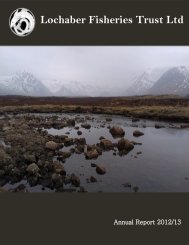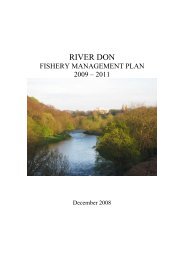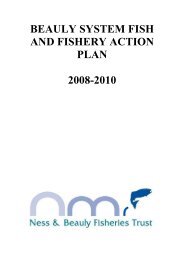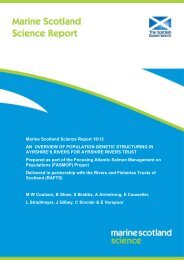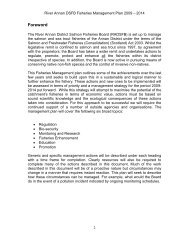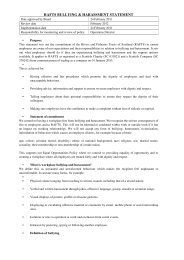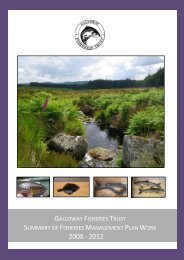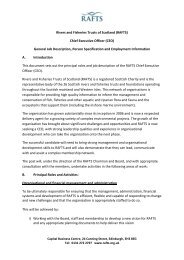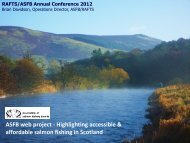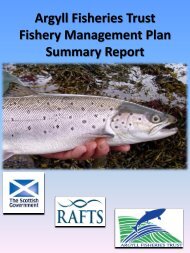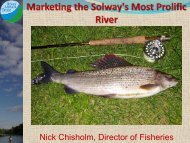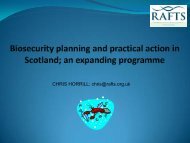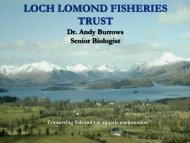Loch Fitty coal mining development: forming a fish mitigation
Loch Fitty coal mining development: forming a fish mitigation
Loch Fitty coal mining development: forming a fish mitigation
Create successful ePaper yourself
Turn your PDF publications into a flip-book with our unique Google optimized e-Paper software.
Centre for River Ecosystem Science<br />
<strong>Loch</strong> <strong>Fitty</strong> <strong>coal</strong> <strong>mining</strong> <strong>development</strong>: <strong>forming</strong> a<br />
<strong>fish</strong> <strong>mitigation</strong> and restoration strategy<br />
Colin Bull & Theo Philip
<strong>Loch</strong> <strong>Fitty</strong>, Fife<br />
December 2007 – <strong>fish</strong>ery closed “significant water<br />
problems and problems with <strong>fish</strong> health”
St.Ninians Surface<br />
Mine, Kelty<br />
• In operation since<br />
1998<br />
• Direct employment<br />
for 90 staff<br />
• Supplies circa 11%<br />
of Longannet’s<br />
annual <strong>coal</strong>-burn<br />
• Meets the electricity<br />
needs of 240,000<br />
people each year<br />
Southern extension:<br />
• Nationally significant reserve of<br />
<strong>coal</strong> – 3.4Mt located beneath<br />
<strong>Loch</strong> <strong>Fitty</strong><br />
• Timeframe : 6 years <strong>coal</strong>ing,<br />
18 months restoration<br />
• Fife Council resolved to grant<br />
planning permission Sep 2011<br />
• CAR application submitted to<br />
SEPA Nov 2011
Southern Extension Design Overview: construction sequence<br />
St.Ninians<br />
<strong>Loch</strong> <strong>Fitty</strong> Burn<br />
Lassodie Burn (divereted)<br />
Meldrums Mill Burn<br />
Hot Water Burn<br />
EMC<br />
Unnamed Burn<br />
Kingseat
<strong>Loch</strong> <strong>Fitty</strong> Restoration Plan<br />
• <strong>Loch</strong> <strong>Fitty</strong> currently in downgraded condition - Poor Ecological Status<br />
• Main causes: poor water quality, compromised hydromorphology (deep<br />
mine & <strong>fish</strong>ery alterations to loch), and the presence of non-native species<br />
• Development proposal offers a solution to improving the status of <strong>Loch</strong> <strong>Fitty</strong><br />
for the longer term through remediating historic water quality problems,<br />
restoring the loch’s hydromorphology and removing non-native species.
<strong>Loch</strong> <strong>Fitty</strong>: Fish community aims:<br />
• Re-establish <strong>Loch</strong> <strong>Fitty</strong> as a waterbody of Good Ecological Status<br />
• Removal of Argulus foliaceus (L)<br />
• Restore self-sustaining <strong>fish</strong> community representing a more native species<br />
assemblage<br />
Common name<br />
Brown trout<br />
European eel<br />
3-spined<br />
stickleback<br />
Stoneloach<br />
Brook lamprey<br />
Roach<br />
minnow<br />
Rudd<br />
Perch<br />
Pike<br />
Current <strong>fish</strong> community<br />
Species name<br />
Salmo trutta<br />
Anguilla anguilla<br />
Gasterosteus<br />
aculeatus<br />
Neomacheilus<br />
barbatulus<br />
Lampetra planeri<br />
Rutilus rutilus<br />
Phoxinus phoxinus<br />
Scardinius<br />
erythrophthalmus<br />
Perca fluviatilus<br />
Esox lucius<br />
Aspirational <strong>fish</strong> community<br />
Common<br />
name<br />
Brown trout<br />
European eel<br />
3-spined<br />
stickleback<br />
Stoneloach<br />
Brook lamprey<br />
Atlantic salmon<br />
??<br />
Species name<br />
Salmo trutta<br />
Anguilla<br />
anguilla<br />
Gasterosteus<br />
aculeatus<br />
Neomacheilus<br />
barbatulus<br />
Lampetra<br />
planeri<br />
Salmo salar
Establish the current status of the<br />
<strong>fish</strong> community and extent and<br />
quality of habitats:<br />
Fish community:<br />
Stillwater sampling = NS Share Methods<br />
Manual V Fish): 8 x Norden multimesh<br />
gillnets, 8 x fyke net gangs. Additional<br />
attempts at beach seine netting and<br />
electric <strong>fish</strong>ing in margins<br />
Channel network: electric <strong>fish</strong>ing sampling<br />
(SFCC full quantitative, timed) and lamprey<br />
semi-quantitative at suitable habitats).<br />
Fish health:<br />
Institute of Aquaculture - <strong>fish</strong> sampling<br />
Fish habitats:<br />
Habitat surveys in inflowing stream network<br />
(Hendry and Cragg-hine, 1996)
Fish community of <strong>Loch</strong> <strong>Fitty</strong><br />
• Roach and perch populations dominate numerically , populations<br />
fluctuate. Pike and eels also present.<br />
• Minnow and 3-spined stickleback not sampled but present in<br />
inflow and outflow<br />
• Unlikely that native brown or introduced rainbow trout remain in<br />
main waterbody, but brown trout present in inflow and outflow<br />
• Unlikely that Lampetra ammocoetes present<br />
• Side ponds contain same <strong>fish</strong> species but Rudd may still be present<br />
(not captured during sampling campaign)
Meldrum’s Mill<br />
Burn (main inflow)<br />
•Roach, perch, pike, minnow , stoneloach,<br />
trout, stickleback, brook lamprey present.<br />
•Roach dominate community numerically<br />
in lowermost reaches<br />
•Trout present both upstream and<br />
downstream from impassable falls , but<br />
very low densities (juvenile and mature<br />
<strong>fish</strong>)<br />
•Lampetra ammocoetes encountered in<br />
tiny sub-optimal habitat patches in lower<br />
reaches.
Argulus foliaceus (L.)<br />
• Branchiuran, freshwater louse, size 6-8 mm, low host specificity<br />
• Free-swimming juveniles seek hosts, attach and begin feeding<br />
immediately<br />
• Induces reduced <strong>fish</strong> growth, performance, disease resistance and<br />
lower reproductive success rate. May result in death.<br />
• Economic impact, angler’s perception of Argulus as a problem.<br />
2010: “The presence of the Arguluid parasites is probably<br />
the more significant health-related finding”.<br />
= 7% prevalence<br />
Both inflow and outflow streams are potential<br />
reservoir for re-infection of <strong>Loch</strong> <strong>Fitty</strong> in future.<br />
Measures required to prevent Argulus transfer to<br />
EMC and subsequently to the restored <strong>Loch</strong> <strong>Fitty</strong>.
Fish <strong>mitigation</strong> and restoration<br />
planning<br />
Phase 1: Establish distribution of species and<br />
Argulus foliaceus in loch and channel<br />
network<br />
Phase 2: EMC connection - prevent colonisation<br />
by undesirable species and Argulus foliaceus<br />
Phase 3: <strong>Loch</strong> de-watering phase: fate of <strong>fish</strong><br />
Phase 4: Monitoring establishment of <strong>fish</strong><br />
community in EMC (during <strong>mining</strong>)<br />
Phase 5: restoration of <strong>Loch</strong> <strong>Fitty</strong> post-<strong>mining</strong>
Phase 2: Establish EMC and prevent colonisation by<br />
undesirable species and Argulus foliaceus<br />
• Fish screens to prevent<br />
colonisation from channel<br />
network. Eventual<br />
replacement at outlet<br />
with low-head weir with<br />
eel pass.<br />
• Eradication of <strong>fish</strong> in<br />
inflowing stream section<br />
to prevent colonisation by<br />
undesirable <strong>fish</strong>.<br />
• Natural colonization of<br />
EMC <strong>fish</strong> from upstream<br />
Argulus-free populations.<br />
• One of EMC functions is<br />
to provide refuge and<br />
forage for otters during<br />
<strong>mining</strong> operations.
Phase 3- dewatering <strong>Loch</strong> <strong>Fitty</strong> and fate of <strong>fish</strong><br />
De-watering by pumping<br />
over 3 month period to<br />
Thortonwood <strong>Loch</strong><br />
Fish pumping and removal<br />
project.<br />
Small number of specimen<br />
<strong>fish</strong> rescued<br />
Concerted effort for eel<br />
capture in 3 month period<br />
prior to de-watering
• Eel swimbladder parasite<br />
Anguillacola crassus<br />
Eel translocation options:<br />
• <strong>Loch</strong>fitty Burn<br />
• Standing waterbodies on<br />
<strong>Loch</strong>fitty burn network<br />
( <strong>Loch</strong> Ore?)<br />
• Other neighbouring<br />
recipient waterbody (<strong>Loch</strong><br />
Leven ???)<br />
• Suitable waterbody with<br />
restricted upstream<br />
connectivity ??<br />
• Estuarine habitat ??
Phase 4: Monitoring establishment<br />
of <strong>fish</strong> community in EMC<br />
(during <strong>mining</strong>)<br />
• Regular monitoring of channels and EMC ponds<br />
for <strong>fish</strong> and parasites.<br />
• Contingency planning in place to address<br />
biosecurity issues should they arise.<br />
• Consider introducing forage <strong>fish</strong> species for otters<br />
• Carry out habitat improvement works on<br />
inflowing channel network to maximise their<br />
potential as nursery areas for brown trout
Phase 5: restoration of <strong>Loch</strong> <strong>Fitty</strong> post-<strong>mining</strong><br />
• Reconnection and filling of<br />
restored <strong>Loch</strong> <strong>Fitty</strong><br />
• Outlet <strong>fish</strong> barrier remains<br />
in place to prevent<br />
upstream migration of<br />
undesirable <strong>fish</strong> species<br />
• Monitor <strong>development</strong> of<br />
ecosystem and <strong>fish</strong><br />
community through time<br />
• Consider supplemental<br />
stocking in nursery<br />
streams to assist<br />
establishment of brown<br />
trout population and<br />
assess / modify as required
SWOT<br />
• Strengths: native brown trout population in catchment<br />
so natural source for future restoration.<br />
• Weaknesses: Argulus foliaceus, presence (and<br />
distribution) of undesirable <strong>fish</strong> species.<br />
• Opportunities: translocation of eels, restoration of<br />
more representative <strong>fish</strong> community, sustainable<br />
angling resource for future<br />
• Threats: <strong>fish</strong> introductions, incomplete eradication of<br />
Argulus , or undesirable <strong>fish</strong> species, unsuitability of<br />
habitat for brown trout<br />
Restoration Design Team:


